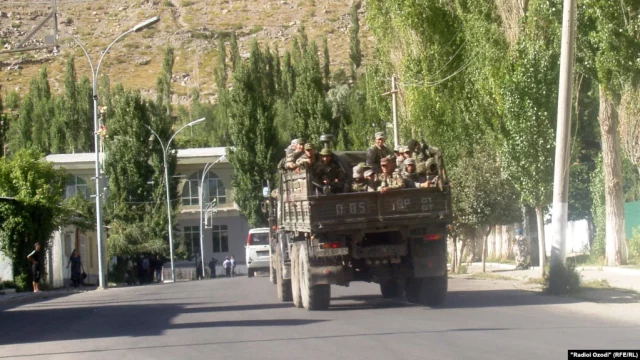Paul Goble

Dushanbe has never exercised complete control over Tajikistan’s restive Gorno-Badakhshan, a remote region dominated by the Pamir Mountains that occupies a third of the country (even though it has only 3 percent of its population) and adjoins Afghanistan. But in recent weeks, the situation has deteriorated to the point that ever more people in Dushanbe and Moscow are openly talking about the risk that conditions there may soon trigger a full-scale civil war. That possibility has led the Tajikistani leadership to launch yet another and apparently far more massive “counter-terrorist” action in Gorno-Badakhshan—so far with limited success (Fergana.agency, May 18; IA-Centr.ru, EurasiaNet, Sputnik News, May 19).
Perhaps more significantly, Dushanbe’s problems have compelled it to publicly ask Moscow to be ready to send forces into the region, just as it did in Kazakhstan last January. Several days ago, an obviously worried Tajikistani President Emomali Rahmon told a summit of the Collective Security Treaty Organization (CSTO) in Moscow that Russia must be ready to do so on the model of its intervention in Kazakhstan (Stanradar.com, May 20). Other Tajikistani leaders have since made the same case. And at least in part because of this trend, ever more Russian commentators are now suggesting the Kremlin may have to agree, despite being hard-pressed by its war in Ukraine. As they contend, the problems in Tajikistan threaten not only that country and Central Asia but Russian national security as well (Izvestia, May 22).
Increasing the likelihood that Moscow will decide in favor of such a course is something that has often been overlooked. Neighboring Afghanistan represents a religious threat to Tajikistan that is different and perhaps more powerful than the Taliban. It involves the Ismailis, a sect of Islam led by the Aga Khan, which the Taliban opposes but that has many followers in northern Afghanistan and especially in the Gorno-Badakhshan region of Tajikistan. If the Aga Khan gains influence, it could prompt a Chinese intervention because Beijing views him as a dangerous threat and already has military capabilities in Tajikistan that are arrayed and ready to take action. Moreover, Beijing has earlier signaled it would like to take control of the Pamirs (see EDM, July 30, 2020 and December 7, 2021). That could set up a particularly dangerous Sino-Russian conflict. Moreover, Russian analysts stress, the Aga Khan is not an independent actor but rather allegedly an agent for the West. And thus, Western countries may supposedly use him to push Russia out of Tajikistan and perhaps Central Asia—a strategy Moscow must oppose (Fondsk.ru, May 17; Nezavisimaya Gazeta, 66.ru, May 18; Nakanune.ru, Izvestia, Vpoanalytics.com, May 20).
But some dissenting voices point out that the problems in Gorno-Badakhshan are long lasting and largely internal; a military intervention will not solve the situation but could, in fact, worsen things for Moscow. The eastern third of modern-day Tajikistan has always been a law onto itself, a place where the writ of Dushanbe has run only intermittently and where outside powers have repeatedly engaged in geopolitical competition—from the Great Game of the 19th century to more recent jockeying for influence between Russia, China and Afghanistan. Moreover, since Tajikistan acquired independence in 1991, the region has itself continued to be a source of unrest, the base for anti-Dushanbe forces during the country’s civil war in the 1990s, and later, a place where ethnic Pamiris from Afghanistan have exercised a disproportionate and fissiparous influence on the Pamiris of Tajikistan. At various times in the past, when conditions in Gorno-Badakhshan have deteriorated, Moscow has talked about intervening, ultimately without following through; but this time appears to be different (see EDM, April 30, 2020, November 30, 2021, February 15, 2022).
Tajikistan’s own use of force has not worked, some local analysts argue, pointing to the series of “counter-terrorist” actions that have failed to bring the restive region to heel; but if Moscow intervenes now, they contend, the conflict will likely grow rather than diminish. Many Tajikistanis even beyond the borders of the Gorno-Badakhshan would see such a move as highlighting the weakness of their own government and dispose more of them to listen to Islamist radicals from Afghanistan, thus triggering the broader civil war that the intervention would be intended to stop. In such a scenario, Russia would not be able to come in and quickly leave, the way it did in Kazakhstan. Thus, the Kremlin would face the awful choice of committing its increasingly scarce military resources (needed in Donbas) for the long term or having to withdraw with little to show for its efforts besides a more hostile Tajik population, a large number of whom are living and working in Russia itself. At the same time, the Russian population may itself grow increasingly agitated if their country’s military expedition in a far corner of Central Asia begins to go badly (Azattyq.org, May 19; Nezavisimaya Gazeta, May 18).
Nonetheless, Russia’s President Vladimir Putin, who promotes himself as the protector of existing governments among his CSTO allies, may decide that he has no choice. After all, worsening armed conflicts between Dushanbe and the population of Gorno-Badakhshan, on the one hand, as well as along the Tajikistani-Afghan border, on the other hand, would further erode his regional credibility and influence. Consequently, a Russian military intervention in Tajikistan is now more likely than not, despite the pressures it would place on a Russian army already tied down in Ukraine. But much may depend on whether the population of this far-flung mountainous region once again shows it is not prepared to bow its head to Dushanbe or, indeed, to anyone else (Stanradar.com, May 18).
No comments:
Post a Comment